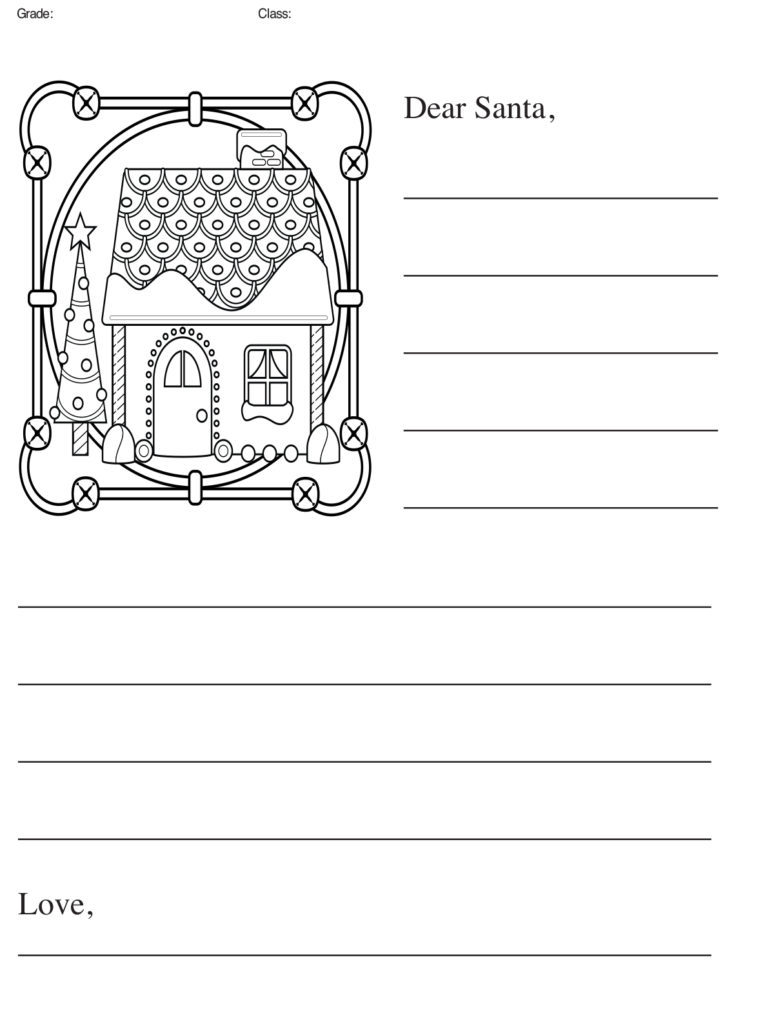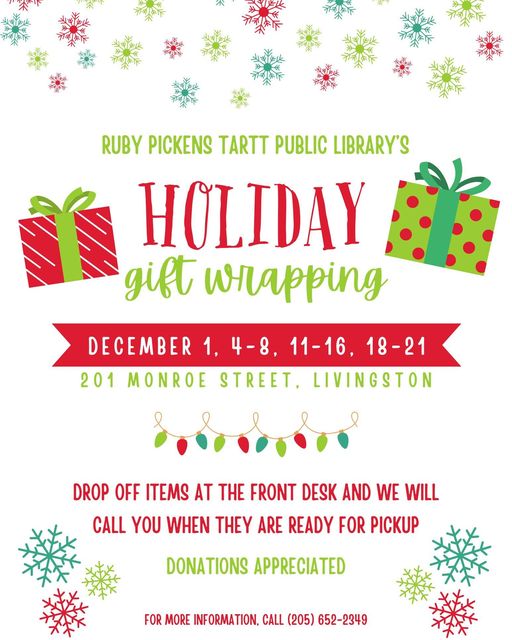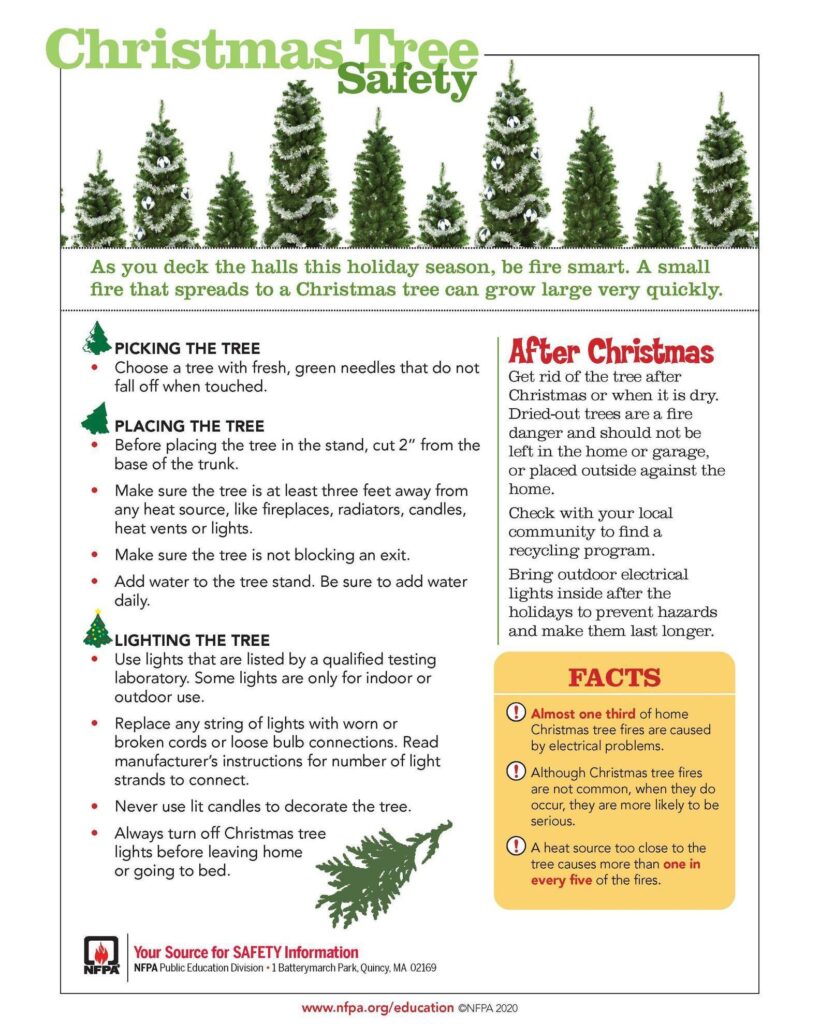
Don’t forget Santa Letter’s deadline is always the first Friday in December, Dec. 1st.
Click on the Santa letter above for a free downloadable coloring page.

It’s time for Santa Letters again.
Santa Letters must be in by Friday, Dec. 1. These will be run in the Christmas Special edition. Please don’t edit them! We want them just as they are. Misspellings just make them cuter and show the developmental age they are. It takes one person 48 – 60 hours to type them all and only up to 2nd grade please. We don’t have enough room for more. Special needs kids are excluded from the 2nd grade rule, of course, and may submit one. Also, please feel free to use your own Santa letter forms if you like. We plan to put any colored/artistic ones we get on the website right before Christmas.
You can snap a photo, scan in or screen shot it and email is [email protected] and we’re are located at 210 S. Washington St., Livingston, with our news stand out front. Feel free to drop letters off at the office, but call ahead 205-652-6100. We have to leave all the time to cover events and stories, and we want to be sure to be there to take your letters. We’ll call or email and give the schools a reminder deadline week. Please let us know if you need to pick them up from the school.
Thank you!
Sumter County Record Journal






Gather Hear Alabama Tour at CCA
Join us for a special afternoon of music and dance! Mii Sawada begins her Gather Hear Alabama Tour in York, Dec. 2, 3 p.m. We couldn’t be more excited! Our CCA Elite Ballet dancers and Layla Love of The Dance Centre will join Ms. Miki in recital for her performance in York. You don’t want to miss this holiday special! Free and open to the public!
Colman Center for the Arts Soul Cinema Trivia Night
Bring your folks and join us for an unforgettable night of Soul Cinema Trivia Nov. 25, 6-9 p.m., featuring the super fun card game Role Call! Come out and have some post-Thanksgiving fun (and compete to win prizes)! Free and open to the public. Refreshments will be served.
CCA Holiday R & B Sing Along
Let’s sing our favorite Holiday R&B songs together Dec. 16, 6-9 p.m.Refreshments and holiday cheer will be available. Email song requests in advance to [email protected].


Angel Tree 2023
Your Angel Tree donations help to bring hope and happiness to local individuals and families. The goal this year is to assist with gifts for 200 kids and 10 elderly residents. Donors are asked to stop by or contact the Sumter County DHR Office to select a tag from the Angel Tree Nov. 4- Dec. 12. The tag will list the assigned number for your angel and their wish list.



SSCC Holiday Events
Shelton State Community College (SSCC) has announced its schedule of holiday events for 2023.
The Martin Campus and C.A. Fredd Campus will close Wednesday, November 22 through Friday, November 24 for Thanksgiving. The College’s regular hours of operation will resume on Monday, November 27.
On Tuesday, November 28, the SSCC Music Department will host the College’s Annual Tree Lighting and Sing-Along at 1:00 p.m. in the Martin Campus Atrium. Sacred and secular holiday pieces will be performed, and the audience will participate in a sing-along. In addition to musical offerings, this year’s event will mark the introduction of Dr. Jonathan Koh as the College’s President and include a special recognition of retirees in attendance. A reception will immediately follow. Now in its thirteenth year, Here Comes Santa Claus is sponsored by the Shelton State Ambassadors and allows students, faculty, staff, and community members to assist those in need. Donations will be accepted through Fri., Dec. 8. To learn how to help, contact Miranda Zapata at [email protected].
The Music Department will present its annual Christmas Concert on Thurs., Dec. 7, at 7:30 p.m. in the Martin Campus Atrium. Featuring the Shelton Singers and the Shelton State Jazz Ensemble, both events are free and open to the public.
On Wed., Dec. 13, the College will sponsor Brunch & Boogie with Seniors at the McDonald Hughes Center from 10 a.m.-1 p.m. The event is free and open to senior citizens. The college will be closed for the holidays Dec. 22- Jan. 2. Regular hours of operation will resume on Wed., Jan. 2, with spring classes beginning on Mon., Jan. 8, 2024. For more information, contact SSCC Media and Communication at [email protected].
Of Crud and Crumbs: Santa Goes South

By Madoline Thurn
‘Way back in my very early adult stage, I was married to a military guy. It was a great life. Every few years the military transferred you to another city – expenses paid. You just didn’t get much say-so where they sent you. Of course they gave you a form– the guys called called it “the dream sheet” – three choices you wished to be sent to. Then they didn’t sent you to any of these places.
Well, we were stationed in a historical southern city. Nice location; we loved it. But it was time for a transfer. We were transferred to a farther north, popular coastal military facility. Exciting.
The movers came, packed up all our earthly possessions and headed north. And! At the last second, Military Mate received orders for temporary duty. In the other direction.
Everybody’s idea of a dream vacation- a state with nothing but sun, sand and surf. And a few orange trees and avocado trees. So the natives could at least know what a tree looks like. Now, I like mountains and forests and steep, curvy roads.
But hey! Holiday season is approaching. The warm sun will be wonderful. So we found an efficiency apartment and settled down while Military Mate accomplished the task he was sent to do; whatever that was. Maybe they just thought he needed a sand/sun/surf vacation. We fell quickly into that forever-on-vacation mindset.
The Christmas cards we mailed home depicted Santa relaxing under a palm tree; his boots had been removed and lay half buried in the sand while Santa wiggled his toes and wore the most relaxed expression. His reindeer frolicked in the surf or rolled in the sand. His empty sleigh was overturned at the surf’s edge, each wave moving it farther out to sea.
Well. When my sister received her card, it gave her young smart-aleck son all the ammunition he needed for a jolly holly holiday. Or, I should say ‘hollering.’ He teased his younger sisters to the point of hysteria. “Santa’s not coming! See! Here’s a picture of him on vacation in the sunny south.”
My sister admonished, “If you don’t stop scaring your sisters, he’s not coming to see you,” But he was older and wiser (smart-alecky) and knew the facts.
And my sister sent me a curt directive, “From now on just sent the customary Christmas card depicting Santa in his sleigh, being drawn by his dependable reindeer, flying over a city, icicles clinging to the eves of houses, a mist of snow drifting. Don’t send Santa on a sun/sand/surf vacation again.”
Of Crud and Crumbs: Magic Christmas
By Madoline Thurn
No prince or princess ever had a Christmas as magical as ours. A few days before Christmas, Daddy would take us to chop down the tree. The tree! All year we had kept our eyes open for the prettiest one. Finally the day would arrive. Daddy would loudly announce, “Get your coats on, young’uns. Let’s go get the Christmas tree!” Bedlam! Exuberant children crazy with excitement, jumping up and down, shouting. Mama, hampered by our anticipation, cannot button our coats fast enough.
“I’ll tie Baby’s shoes.” I’ll get the ax,” we volunteered. “Hurry, Mama, they will leave me,” we squirmed as Mama tied shoes and buttoned coats. Through it all, Daddy beams ineptly, leaning on the door frame.
Impatient children, scattered from wide-open door to gate, “Come on, Daddy. Hurry!” Amid it all, Mama is admonishing Daddy, “Now, Algie, you take care of those chill’un. Don’t let ’em get their feet wet. Make ’em keep their coats buttoned. See that the baby keeps up.”
Daddy lifted Morris high up on his shoulders, holding his leg securely with one hand and the ax with the other. We all set off, running, shouting, so full of joy and anticipation we could barely endure it. Mama stays home and visualizes horrible scenes. Daddy is going to let all of us fall into the rushing, swollen creek; let us all get lost; get all our arms and legs chopped off with the ax. Daddies do not know one thing about protecting children.
We return home safely – our feet wet, our coats off and our hands and noses red from the cold. But we’re still exuberant. Mama fusses. “I see we’ll be up all night tonight with the mustard plasters and hot poultices.” Daddy puts the Christmas tree up for us, nailing two boards in the shape of a cross to the bottom of the tree. We begin immediately to decorate it. We would color strips of paper and glue them into chains, using paste made with flour and water.
Other decorations consisted of sweet gum balls wrapped in scraps of material. During the summer, as we walked along the road we picked up discarded cigarette packs, saving the aluminum foil, which we also used to wrap sweet gum balls; a few icicles carefully saved from year to year. And finally the crowning glory. Previously, Daddy had bought two glass ornaments – one red and one blue. They were our most prized ornaments. We would save them until last and hang them in front, arguing about the most prominent position. After we got the tree decorated, we would spend hours looking at it. It was the prettiest sight on earth. And the scent of cedar permeated the room, a smell so uniquely Christmas. Miracle. Not one of us developed the croup during the night; therefore Mama and Daddy didn’t have to be up all night applying mustard plasters.
Mama would bake sweet potato pies, anything she could get her hands on to make a pie. She managed somehow to obtain the ingredients for a fruit cake, the true Christmas tradition. We children didn’t like fruit cake but it made the house smell good.
Then we began the wait. Time dragged. Back then children didn’t tell Santa what they wanted him to bring them. Santa didn’t make before-Christmas visits. He just brought you whatever he had in his sack, and he gave it to you because you had been good.
Very few people owned radios. And the ones that did, did not keep them on all the time; they only turned them on to get the evening news – fifteen minutes at six o’clock; and the Grand Old Opry on Saturday nights. So, therefore we weren’t inundated with Rudolph the Red-nosed Reindeer and Jingle Bells.
Christmas eve night we would snuggle close to the fire. Daddy, holding the baby, would read the Christmas story from the Bible. It was always the prettiest story I had ever heard; it made Christmas really Christmas.
After Daddy had finished reading and we had said our prayers, we would rush off to bed, afraid Santa would catch us awake and not leave us anything. Mama would cover us up and kiss each one of us. Then we would squinch our eyes tightly closed and poke our heads under the cover.
But we couldn’t keep our heads covered and our eyes closed. Sleep failed. Fire twinkled in the fireplace, making dancing fantasy shadows on the walls and ceiling. We would squinch our eyes closed again and call, “Daddy, tell Santa we are asleep now.” Truly, a trusting child could almost hear sleigh bells.
When we awoke Christmas morning the house was as cold inside as the weather was outside. Cold prickled our skin like hundreds of little needles. Mama admonished, “Stay in bed until Daddy gets the fire started.”
We couldn’t wait. Santa Claus had come! Maybe a doll; maybe cowboy pistols and holsters. But for sure some jacks and dominoes and some story books.
And a coloring book and a box of crayons. We always chose the prettiest picture for Mama to color. It was always a bird sitting on a limb, singing. At first it was just a black and white outline, but Mama could transform it into a robin, or bluebird, or a cardinal, sitting on an apple branch or a peach or cherry branch.
The same crayons that would be light in spots and dark in spots and lines running every which way for us would turn into smooth soft pastel shades for Mama – pink, violet, pale blue, mist green – shades so light they seemed to have been brushed with a feather. Mama loved to color. Sometimes we would discover a picture she had colored after we went to sleep.
Sometimes she would be foolhardy enough to attempt to color while we were still awake; inquisitive children trying to climb onto her lap, bumping her arm; little ones between her and the picture, trying to discover how she paints so prettily.
So she usually colored after we were asleep. We treasured her pictures and wrote her name on them, “Mama.”
Of Crud and Crumbs: The ugliest Christmas tree in the world – according to my grandson
By Madoline Thurn
War and poverty through the eyes of a little girl
Written by Bertha Pruitt, Gainesville resident
She was born in the backwoods of rural Alabama during World War II. She was the ninth child born to sharecroppers. Her earliest recollection is the fall of 1945. She vividly remembers the family being issued some rations and war bonds called “sugar stamps.”
Each month when the stamps arrived, her father and three brothers would head to town . to purchase the basic staples which were not raised on the farm.
This consisted of a sack of flour, sugar, coffee, and a sack of Uncle Ben/Carolina Rice. The cornmeal was ground from corn (grown on the farm ) and taken to the grist mill for grinding. Milk, butter, eggs and chickens were all raised on the farm.
They processed syrup from sugar cane. Farm life was pretty routine. One had to rise early each morning to feed the farm animals and milk the cows in order to have fresh milk and butter before heading off to work on the farm. If the family was not in the field by sunrise, they were considered lazy by their neighbors.
They were to work from sunup to sun down with a one hour lunch break. Children under the age ten were allowed to stay at home with their smaller siblings and do the entire household chores. In many cases, this also meant cooking meals for the family.
The children were allowed to go to school for approximately four or five months out of the school year (only when there was no work to be done on-the farm).
It mattered not to this young mind that the country was at war or that the “sugar stamps” were being issued by the government because of dire poverty. The one bright moment during this period was Christmas 1945 – one of her older sisters got married at their home. Preparations were always made in advance for the two-week long holiday celebration. The children were busy cleaning and sprucing up their home. The yard was swept with brooms made from dry, tall grass that turned into straw in the fall. The bark around the trees was white washed with lime and water. The children would go into the woods and break branches from red berry bushes to be used as decoration for the doors and windows, as few could actually afford Christmas trees. This was always done for the season. But this was not an ordinary Christmas; pigs were fattened for the kill along with chicken, turkeys and other wildlife that could be acquired from hunting – a learned profession for the men.
Dec. 24, 1945 was different. This youngster had never witnessed such an event taking place right before her own eyes. Neighbors and family were traveling near and far by foot, carrying baskets of food, cakes and pies that they had spent weeks baking.
The men were busy outside roasting pigs and brewing up big cast iron pots of gumbo soup called bunion in that area. One of the elders was playing the fiddle, someone was playing the drum (a tin can), while another was blowing the harmonica.
The children stood in awe, peeping from the corners of the house or hidden behind bushes to watch and hear. They were not allowed to get involved in grown-up frolic, especially with the men folk.
The day arrived for the big event. The stage was set up (two cardboard boxes) covered with handmade sacks. The children had gone into the woods and collected holly branches, which were set up on both sides of the stage. Everybody was dressed in their finest clothing. The bride, age 16, was adorned in “something new and something blue.”
She wore a turban, covering her unbraided pigtails, wearing a free-flowing skirt and blouse (all borrowed).
Finally the “stretch limo” arrived. This was a freshly painted wagon, pulled by two mules that had been carefully chosen and released from family duties for this great occasion. The groom descended from the wagon, wearing freshly starched and ironed jeans, a white shirt and shiney dress shoes, which were no doubt borrowed or given to him as a wedding gift by his land owner.
Reverend Brown had arrived very early on horseback, wearing a black Stetson hat and overalls. He carried his preacher’s robe and well – worn Bible. He had come early to get a head start on the food and drinks. He slipped into his robe and went around chatting with his charge (the people of the community) and eating everything in sight. Soon the ceremony was performed. The couple “jumped the broom” and the all-night feast was on.. The bride and groom climbed into the wagon and went throughout the community shouting, “merry Christmas to all and to all a good night.”
1945 was the age of innocence for this little girl. She knew not terror of war, the impact poverty played on one’s life, or the many unfulfilled possibilities. She had no contact with the outside world.
There were no newspapers or magazines. The only battery-operated radio was used strictly by the grown ups, to listen to ball games, or the Amos & Andy Radio Show. The children made mud pies or played games of hide and seek. Toys were made from cans and bottles that were thrown out or other things they could fashion from discard on the farm.
The holiday season brought their greatest joy. Celebrations began on Christmas eve and lasted through the New Year. Plans were made for each of the 12 days of Christmas. The children visited all their neighbors and relatives during this period to collect their gifts.
Often it would be a hand-made garment from one of the relatives, providing they could spare the materials from an extra feed sack or baked goodies from grandma.
Many years later, the little girl can now look back on her past experience with no regrets.
She feels that the exposure of her early childhood (having come up through the rough side of the mountain) has made her much wiser and much stronger. She can now take the dark times into perspective, knowing there will be a bright time tomorrow.

Keep Your Dogs and Cats Safe From Holiday Hazards
This holiday season, while you’re busy decorating, cooking, and wrapping gifts, remember to watch out for holiday temptations for your pets. FDA veterinarian Carmela Stamper tells how to keep your animals safe.
Stocking Stuffers and Pet Treats
If your dog received a stocking full of pet treats, make sure he doesn’t gobble them all up at once. According to Stamper, if he eats the treats whole, or eats too many at once, he may not be able to digest them. Unchewed pet treats can get stuck in the trachea (windpipe) or gastrointestinal tract (esophagus, stomach, and intestines), particularly in small dogs.
If your dog is in obvious distress from eating too much too fast, says Stamper, contact your vet immediately. Some telltale signs are drooling, choking, or vomiting.
Take note of timing. If a bone or chew toy lodges in your dog’s stomach or intestines, the symptoms might not be immediate. Hours to days later, he may vomit and have diarrhea, be less active, not want to eat, and have stomach pain. If the blockage stays there too long, your dog may become very ill. The worst-case scenario is when a hole develops at the blockage site, causing a life-threatening infection.
“When in doubt, contact your veterinarian, who may need to take x-rays or use an endoscope to see what and where the problem is,” Stamper says. Your dog may even need surgery to remove blockages in the intestines.
Tinsel and Ribbons
When decorating your tree and wrapping or unwrapping gifts, keep a close eye on where you leave your leftover tinsel, string, and ribbons.
“Your cat may find these decorations irresistible because they look like easy-to-catch, sparkly, and wiggly prey,” Stamper says. In fact, they can cause serious stomach and intestinal damage.
Symptoms may take a few hours or several days to appear, and include vomiting, diarrhea, lack of appetite, and decreased activity. Play it safe by keeping tinsel off the tree and collecting all ribbons and strings after gifts are opened.
Holiday Plants
If you have holiday plants such as poinsettias, holly, or mistletoe around, take care. When you display (or dispose of) these plants, your cat may decide they’re good to eat, Stamper says.
Poinsettias, for example have a milky white, latex sap that can irritate your animal’s mouth and stomach and may cause vomiting and diarrhea. “If your cat has snacked on poinsettia leaves, you can help him by picking up his food and water dishes for a couple of hours to let his stomach settle,” Stamper advises.
The National Animal Poison Control Center (NAPCC) states that the major toxic chemicals in mistletoe are lectins and phoratoxins. These chemicals affect the heart, causing low blood pressure and slowed heart rate.
“Fortunately for your cat, severe mistletoe toxicity is uncommon and usually occurs only if your pet eats a large amount,” Stamper explains. Symptoms include vomiting and diarrhea, difficulty breathing, slowed heart rate, low blood pressure, and odd behavior.
While holly isn’t as harmful, you should still discourage your pets from eating the berries and leaves, Stamper says. In both dogs and cats, the plant’s toxins can cause drooling, vomiting, diarrhea, loss of appetite, and decreased activity.
Table Scraps
Resist the temptation to give your pet table scraps that are high in fat, such as fat trimmed from meat or skin from your roasted turkey or chicken. “In addition to the typical gastrointestinal upset, rich, fatty foods can cause a potentially life-threatening and painful disease called pancreatitis,” Stamper says. The most common symptoms of pancreatitis in dogs include vomiting, stomach pain, restlessness, shaking, diarrhea, fever, and weakness.
In cats, the symptoms are less clear and harder to notice, such as decreased appetite and weight loss.
And be careful what you put in the trash can, Stamper warns. Dogs, especially, are notorious for helping themselves to the turkey carcass or steak bones disposed of there. As with too many treats, bones can get stuck in your dog’s esophagus, or trachea. Sharp pieces of bones can also injure your dog’s mouth, esophagus, and stomach, and can cause severe internal injuries.
“Don’t forget, once dinner is done, dispose of the leftovers and bones somewhere where your pets can’t get to them,” Stamper says.
Other Human Treats, Including Alcohol
As many pet owners know, chocolate can be dangerous to your dog or cat. Chocolate toxicity depends on the type and amount of chocolate your dog has eaten, his body weight, and if he’s extra-sensitive to the toxic compound in chocolate called theobromine, Stamper says.
Moreover, the seemingly harmless mints common in the holiday season cause life-threatening problems for your dog if they contain xylitol, also found in food items such as candy, gum, some peanut butters, and baked goods, and personal hygiene products, such as toothpaste and mouthwash. Symptoms occur quickly after dogs eat xylitol-containing items, Stamper says. Vomiting is generally first, followed by symptoms associated with the sudden lowering of your dog’s blood sugar (hypoglycemia), such as decreased activity, weakness, staggering, incoordination, collapse, and seizures. Check the package labels to see if they contain xylitol.
After eating chocolate, some pets develop more severe complications, including liver failure, bleeding disorders, and death. If you suspect your dog has eaten chocolate or xylitol-containing items, consider it an emergency and call your veterinarian immediately.
Finally, there’s alcohol. Depending on how much they drink, pets that consume alcohol can develop serious problems. The most common symptoms in pets associated with the consumption of alcoholic beverages are vomiting, diarrhea, incoordination, weakness, decreased activity, difficulty breathing, and shaking. In severe cases, coma and death from respiratory failure (lungs stop functioning) can occur. “Don’t accidentally leave your eggnog on the coffee table,” Stamper says.
Laser toys: how to keep kids safe
The ACT Invites You to the Land of Narnia Just in Time for Christmas
Lucy Pevensie, along with her siblings Peter, Susan and Edmund, invite you to experience the enchanting land of Narnia, as The Actor’s Charitable Theatre (ACT) presents The Lion, the Witch and the Wardrobe at the historic Bama Theatre in downtown Tuscaloosa, Dec. 15-18. Performances are 7:30 p.m. Friday through Monday night, and 2 p.m. on Saturday and Sunday. The Sunday 7:30 p.m. performance includes admission to a 7 p.m. pre-show discussion with Dr. Scott Reynolds, lead pastor of North River Church, on the works and writings of C. S. Lewis Tickets and information are available at www.TheACT.info or (205)393-2800. The Box Office will be open one hour prior to each show time as well.
Many kids (and parents) who have seen Luke Skywalker battle Darth Vader with a light saber think lasers are cool.
What they may not know is this: When operated unsafely, or without certain controls, the highly-concentrated light from lasers—even those in toys—can be dangerous, causing serious eye injuries and even blindness. And not just to the person using a laser, but to anyone within range of the laser beam.
The U.S. Food and Drug Administration is concerned about this potential danger to children and those around them and in 2014 issued a guidance document (PDF 60K) on the safety of children’s toy laser products.
“A beam shone directly into a person’s eye can injure it in an instant, especially if the laser is a powerful one,” explains Dan Hewett, health promotion officer at the FDA’s Center for Devices and Radiological Health.
Moreover, eye injuries caused by laser light usually don’t hurt. Vision can deteriorate slowly and, therefore, may go unnoticed, for days and even weeks. Ultimately, the damage could be permanent, Hewett says.
Some examples of laser toys are:
• lasers mounted on toy guns that can be used for “aiming”;
• spinning tops that project laser beams while they spin;
• hand-held lasers used during play as “light sabers”; and
• lasers intended for entertainment that create optical effects in an open room.
A laser creates a powerful, targeted beam of electromagnetic radiation that is used in many products, from music players and printers to eye-surgery tools. The FDA regulates radiation-emitting electronic products, such as lasers (including children’s toy laser products), and sets radiation-safety standards that manufacturers must meet.
Toys with lasers are of particular interest to the FDA because children can be injured by these products. Because they are marketed as toys, parents and kids alike may believe they’re safe to use.
For toys to be considered minimal risk, the FDA recommends that the levels of radiation and light not exceed the limits for Class 1, the lowest level in regulated products as defined by the International Electrotechnical Commission (IEC).
Lasers used for industrial and other purposes often need higher radiation levels for their intended functions. But these higher levels are not needed for children’s toys—and if they are present, they can be dangerous.
Hand-held laser pointers—often used in business and higher education to help illustrate presentations—have increased in power 10-fold or more over the last decade. And while adults may buy a laser pointer for use in work, kids often play with them for amusement.
The fact that lasers can be dangerous may not be evident, particularly to the children who inappropriately use them as toys, or to the adults who supervise them.
Laser Safety: Tips to Keep in Mind
Remember that laser products are generally safe when they follow the legal limits and are used as directed. But lasers can cause harm if not used properly. The FDA recommends the following general safety tips for consumers.
• Never aim or shine a laser directly at anyone, including animals. The light energy from a laser aimed into the eye can be hazardous, perhaps even more than staring directly into the sun.
• Do not aim a laser at any vehicle, aircraft, or shiny surface. Remember that the startling effect of a bright beam of light can cause serious accidents when aimed at a driver in a car, for instance, or otherwise negatively affect someone doing another activity (such as playing sports).
• Look for an FDA-recommended IEC Class I label on children’s toy lasers. The label says “Class 1 Laser Product,” which would clearly communicate that the product is of low risk and not in a higher emission level laser class.
• Do not buy laser pointers for children, or allow children to use them. These products are not toys.
• Do not buy or use any laser that emits more than 5mW power, or that does not have the power printed on the labeling.
• Immediately consult a health care professional if you or a child suspects or experiences any eye injury.
Watch how fast a dry tree goes up vs. a well hydrated tree…
If your winter holiday tradition includes an artificial or real Christmas tree, you need to be aware of the fire risks. The public buys more than 28 million live Christmas trees every year.* If your tree catches on fire, the fire can spread very quickly.
When you’re decorating with live trees, make sure you keep the tree hydrated. A dry Christmas tree that comes in contact with a flame can catch on fire in fewer than 10 seconds and spread fire and smoke throughout the home.
A few tips to keep your holiday decorations bright and safe:
Choose the freshest cut tree you can find. Check to see if the needles stay intact when you gently pull on a branch.
After making a fresh cut and placing the tree in a stand, immediately fill the stand’s water basin and keep it filled with water until you take the tree out after the holidays. Place electrical cords and lights away from the water.
Choose holiday lights that have a testing laboratory label attached, such as UL, and throw away any frayed or damaged light strands.
Place the tree several feet away from heat registers, space heaters, and fireplaces.
If you decorate with lit candles, make sure they are at least three feet away from the tree and 12 inches away from other decorations and anything else that can burn.
Fire is everyone’s fight. Learn more about holiday fire safety on the U.S. Fire Administration (USFA) website: https://www.usfa.fema.gov/prevention/outreach/holiday.html. Follow USFA on Twitter at @USfire and on Facebook at www.facebook.com/usfire.
TIPS TO AVOID OVERINDULGING ON HOLIDAY TREATS — One of the many pastimes of the holiday season is coming together with family and friends to share a meal with all kinds of savory foods and treats. Dr. Maria Azrad, assistant professor in the department of human nutrition and hospitality management at UA, has several healthy eating tips to keep in mind as you prepare to feast on your favorite foods.
5 TIPS TO MAKE THE MOST OF YOUR NEW YEAR’S RESOLUTIONS — The art of making, and ultimately sticking to, New Year’s resolutions focused on health and wellness can seem like a tall task for some. “The new year often brings excitement for a fresh start and new opportunities for personal goals and self-improvement,” said Sheena Gregg, assistant director of the department of health promotion and wellness and a registered dietitian. “However, New Year’s resolutions can often serve as a point of discouragement when we don’t meet our expectations with our goals.” Gregg provides tips to keep in mind when creating your 2023 resolutions.
UA INFO RADIO PRESENTS SOUNDS OF ‘HILARITAS’ — For the third consecutive year, “Hilaritas,” one of the longest-running performance traditions at the UA School of Music, will air on 92.5 FM UA Info Radio. The program, which includes such holiday favorites as “It’s the Most Wonderful TIme of the Year,” “Feliz Navidad,” and “Do You Hear What I Hear?” will air Friday, Dec. 23, at 7 p.m., Saturday, Dec. 24, at 5 and 8 p.m., and Sunday, Dec. 25, at 8 and 10 a.m., noon, and 3, 5, 7 and 10 p.m.
Holiday Food Safety
FDA gives simple steps to help ensure that harmful bacteria won’t be a guest at your festivities.
How to Cook a Whole Chicken or Turkey
USDA Food Safety 15 Sec -The only way to know food has been cooked to a safe internal temperature is to use a food thermometer.
Poinsettias: Caring for the Christmas Flower
By Justin Miller, Alabama Cooperative Extension System
Poinsettias reign supreme as the main flowers of the holiday season. Also known as the Christmas flower, these beautiful plants offer a variety of colors that compliment any holiday decorations. During Christmas, red and green poinsettias are the most common. However, there are a wide variety of other colors, including pink, white, orange, marbled, pale green and cream. To keep poinsettias thriving through the holidays, there are few things people must do.
Chip East, an Alabama Extension commercial horticulture regional agent, said to have a vibrant poinsettia through the season, the first step is choosing the correct plant.
“When picking a poinsettia, choose one with colorful bracts but one that the blooms have not opened,” East said.
Bracts are the colorful leaves most people associate with the plant. The actual poinsettia flower is the small green or yellow flower in the center of the bracts. Plants should appear full, with dark green leaves attached from the colored bracts to almost the base of the plant. The leaves should be completely free of disease and insects.
Care and Maintenance
Poinsettias do not tolerate high moisture or shaded areas. After purchasing, place the poinsettia in a window seal when possible. They can be moved to areas for display when needed. They thrive in bright sunlight with moderate temperatures no higher than 70 degrees. However, if the sunlight is too direct, the bracts will discolor.
“If a decorative wrap is around the pot, remove the plant from the wrap before watering,” East said. “Allow the water to drain before placing the plant back in the wrap.”
The average lifespan of an attractive poinsettia is about two to four weeks, or with exceptional care, six to eight weeks. However, it is actually a perennial plant that could live for many years. If someone wants to attempt to reflower and maintain their poinsettia, it will need more attention than in the Christmas season.
“Getting a plant to reflower is difficult for the home grower but can be done,” East said. “Spending time to reflower a poinsettia would make a home grower appreciate the nursery that originally grew it.”
For more information on caring for Christmas poinsettias, visit www.aces.edu or contact your county Extension office.